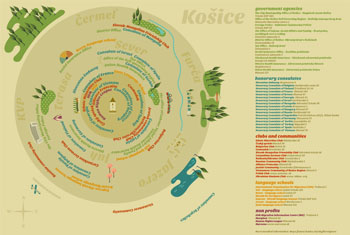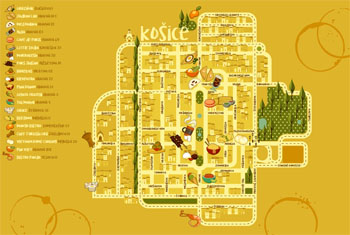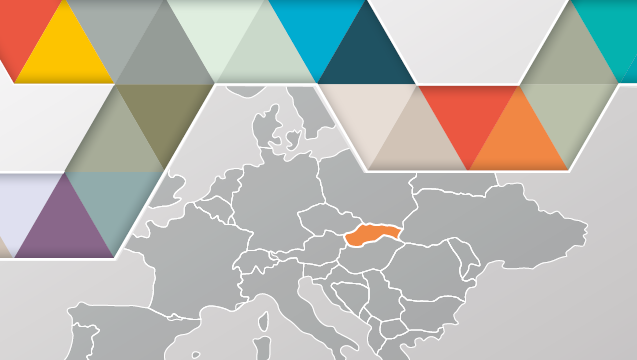What are the reasons for foreigners coming to Košice?
New migration trends suggest – especially for reasons of labour market liberalisation – that it is vital to recruit foreigners, not just the EU citizens, as part of the labour force. Depending on the labour market needs, it could be for both a highly qualified and a low-skilled labour force. With the arrival of high value-added investors and employers, the City of Košice is increasingly experiencing the absence of qualified labour and will be forced to look for and hire human resources from third countries in the future if the number of employees from the catching-up regions of Slovakia is not sufficient enough.
The universities in Košice have a strong tradition of admitting foreign students. The number of students from other EU countries and third countries is increasing each year.
Another reason for coming to Košice may be a family reunification. This may involve different cases, for example, if a Košice inhabitant marries a partner from abroad, or if a spouse, a child or other family member moves to Košice to live with his/her spouse who is a foreigner and who lives in Košice.
How many foreigners live in Košice?
There is trend of an increasing number of foreigners in the past few years in Košice (Košice - surroundings, Košice I, Košice II, Košice III, Košice IV). In 2014, there were 1,574 third country nationals (TCN), and 3,781 TCN in 2018 (approximately 1.6 % of Košice residents). As of 30 November 2018, the Bureau of Border and Foreign Police of the Presidium of the Police Force of the Slovak Republic registers 39 persons granted asylum and 22 foreigners granted subsidiary protection in Košice (i.e. 61 persons granted international protection).
The data provided by the Bureau of Border and Foreign Police of the Presidium of the Police Force of the Slovak Republic shows that there is a noticeable increase in the number of TCN arriving for employment, study or family purposes. Ukraine is strongly ahead, when being compared to other countries where most immigrants come from.
The data correspond to the end of the relevant year, except for 2018 when they are of 30 November 2018.|
Year |
Temporary stay |
Permanent stay |
Tolerated stay |
Total |
|
2014 |
572 |
994 |
8 |
1,574 |
|
2015 |
815 |
1,048 |
7 |
1,870 |
|
2016 |
978 |
1,104 |
9 |
2,091 |
|
2017 |
1,623 |
1,154 |
10 |
2,787 |
|
2018 |
2,563 |
1,217 |
1 |
3,781 |
Source: Bureau of Border and Foreign Police of the Presidium of the Police Force of the Slovak Republic, ETP Slovakia own data processing.
Graph 1: Number of TCN in Košice
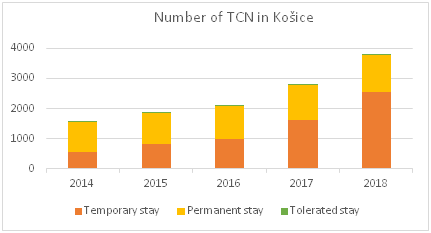
Source: Bureau of Border and Foreign Police of the Presidium of the Police Force of the Slovak Republic, ETP Slovakia own data processing.
Graph 2: Countries from which most TCN come to Košice in 2014
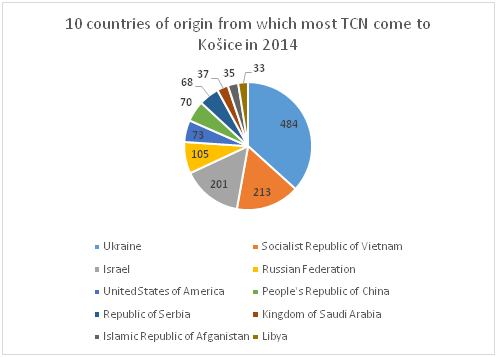
Source: Bureau of Border and Foreign Police of the Presidium of the Police Force of the Slovak Republic, ETP Slovakia own data processing.
Graph 3: Countries from which most TCN come to Košice in 2018
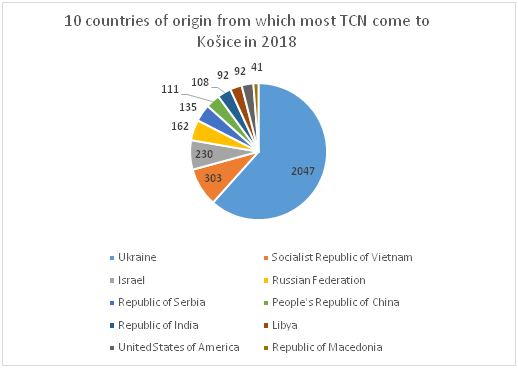
Source: Bureau of Border and Foreign Police of the Presidium of the Police Force of the Slovak Republic, ETP Slovakia own data processing.
The following two graphs provide an overview of the purpose of residence, i.e. why a temporary or permanent residence permit was issued to a TCN. In case of temporary residence, higher education, family reunification and employment (both self-employment and employment) prevail as a purpose of residence. Permanent residence is granted mainly because of family reunification and self-employment.
Graph 4: Number of temporary residence permits based on purpose of residence
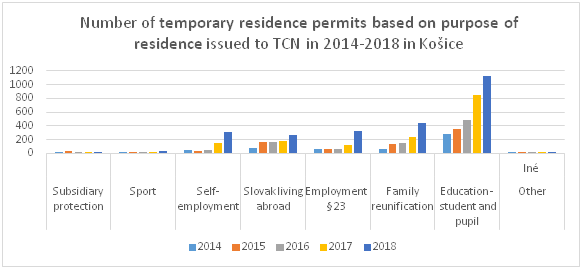
Source: Bureau of Border and Foreign Police of the Presidium of the Police Force of the Slovak Republic, ETP Slovakia own data processing.
Graph 5: Number of permanent residence permits based on the purpose of residence:
§ 43 (1) letter a) permanent residence for five years of a family member of a Slovak national residing in the Slovak Republic, § 46 (1) letter a) permanent residence for an unlimited period after four years of permanent residence, three columns refer to § 52 (1) letter a) according to which TCN, in order to be granted long-term residence, must remain in the territory of the Slovak Republic legally and continuously for a period of five years immediately prior to filing the application, three columns refer to the purposes of residence of TCN prior to being granted long-term residence.
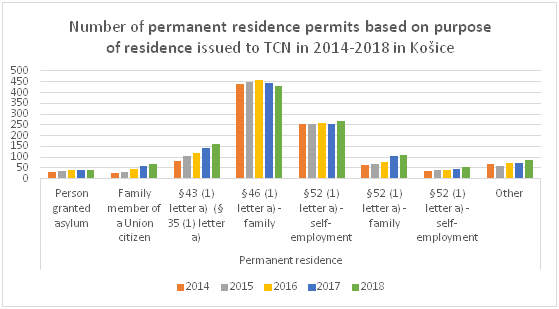
Source: Bureau of Border and Foreign Police of the Presidium of the Police Force of the Slovak Republic, ETP Slovakia own data processing.
The data in the tables below specify the number of TCN in Košice by gender and age as of 19 November 2018. It can be said that as to permanent residence, the number of men and women is more or less equal while the number of men increases significantly when talking about temporary residence. This is particularly evident in case of productive age when men come for work and study in large numbers.
|
Permanent residence |
Temporary residence |
|
|
Men |
654 |
1,667 |
|
Women |
573 |
977 |
Source: Bureau of Border and Foreign Police of the Presidium of the Police Force of the Slovak Republic, ETP Slovakia own data processing.
|
|
Age |
Permanent residence |
Temporary residence |
Age |
Permanent residence |
Temporary residence |
|
|
Men |
0-15 |
50 |
140 |
Women |
0-15 |
49 |
124 |
|
|
16-25 |
45 |
772 |
|
16-25 |
46 |
448 |
|
|
26-40 |
236 |
469 |
|
26-40 |
167 |
251 |
|
|
41-65 |
269 |
278 |
|
41-65 |
211 |
141 |
|
|
66+ |
54 |
6 |
|
66+ |
96 |
17 |
Source: Bureau of Border and Foreign Police of the Presidium of the Police Force of the Slovak Republic, ETP Slovakia own data processing.
Tradition of Multicultural Košice
Multiculturalism is defined as the coexistence of several ethno-cultural groups in one social space. In the past, Košice, as with other Central European cities, has functioned as a laboratory of socio-cultural exchange processes in which several ethno-cultural communication spaces cross. Although, in the second half of the 20th century, Košice lost its multicultural character to a great extent, compared to other Slovak cities, it is still considered to be a city with a cosmopolitan atmosphere and persistent ethnic diversity.
The multi-ethnic character of Košice originated primarily from its location in the contact zone at the linguistic boundary between the Slovak-speaking population north of the City and the Hungarian-speaking south of it. During the High Middle Ages, however, the dominant ethnic group in the City was represented by the immigrated Germans (guests) who maintained their privileged position until the 16th century. In the changed geopolitical conditions of the Early Modern Ages, they had to share the first place with the Hungarians. However, by the 18th century, Košice was marked by the increasing dominance of the Slovak-speaking population, inhabiting mainly the growing suburbs that were gradually merging with the inner City. The intertwining and several centuries of co-existence of the three dominant ethnic groups in Košice, together with the Jews, Roma and Ruthenians in the common urban area, generated a typical feature of multi-ethnic cities – multilingualism of the local population.
The extended language repertoire of the majority of Košice residents was crucial in the later process of homogenisation and nationalisation of its ethnic identities, allowing them to switch between ethno-identification codes depending on changes in political regimes (1918 → 1938 → 1945). The Holocaust in 1944 and the struggle for the national character of the City during the 20th century, when two national regimes – Hungarian and (Czecho-) Slovak – sought to eradicate the local ethnic cultures, caused Košice to largely lose its traditional status of a “salad bowl” (also called a cultural mosaic in which several cultures co-exist) and transformed it into a “melting pot” in which its population was nationalised in favour of a national idea concerned.
In spite of the process of ethnic homogenisation – after the Second World War, in favour of the Slovak ethnicity – the ethnic diversity was not completely eliminated. In addition, in the second half of the 20th century, the immigration of the Roma increased, which made the Roma the second most numerous ethnic minority in the City today (8 % according to scientific estimates).
The political and intellectual elites of the City reflect the multicultural past and present of Košice. The idea of Košice as a city of tolerance has been an iconic image of the City since the 1990s and is an important part of self-presentation to its residents, visitors and foreign partners.
/Košice in the Slovak Historiography, Ondrej Ficeri, 2016/

